The Pacific Northwest is often referred to as ‘wet’ and ‘rainy’. But from mid-July until late September or early October, we can be very dry, with little rainfall. If you don’t irrigate, your soil can become quite dry in a short time. There are measures you can take to keep your soil from drying out too much. One of the best measures is to keep your plants mulched, with a 2″-3″ layer of coarse organic material such as bark mulch or wood chips. Improving your soil by adding organic amendments can also help. Grouping plants together so that plants that need more summer moisture are all together makes watering easier. But if you are still planning your garden, one of the best things you can do is choose plants that are tolerant of summer drought.
All plant need supplemental water the first few seasons after planting. Plants in full sun will need more water than those in shade. Great Plant Picks is great resource for plants that work in our climate. Here is a list of plants from them that are drought tolerant in the Pacific Northwest.
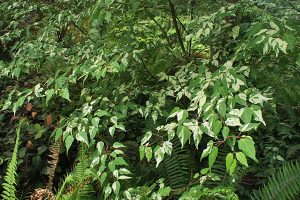
Variegated Hawthorne Maple
Trees
- Acer species Some species of maple are quite drought tolerant when established. Acer griseum or Paperbark Maple will grow to 25′ in 30-40 years. Acer circinatum, Vine maple, is a native understory tree that is adapted to our dry summers. Acer crataegifolium, Hawthorne Maple, will grow to 15′ and thrives even in dry shade. In winter wet soils that are dry in summer, try cultivars of Acer rubrum, Red Maple, or hybrids like Pacific Sunset. These trees grow 25′-40′ in 20-30 years.
- Arbutus unedo. Strawberry Tree. Small evergreen tree with ornamental strawberry-like fruits in the fall. A close relative of our native Madrone, which is also drought tolerant but difficult to establish.
- Cedrus sp. True Cedars. Many cultivars of Deodar Cedar, Atlas Cedar, and Lebanon Cedar are available, from small dwarfs to moderated sized trees. Most prefer sun.
- Cornus mas Cornelian Cherry. Upright shrubby tree, to 10′, with winter bloom of yellow flowers, followed in late summer by astringent red fruit. Tolerates most soils.
- Ficus carica. Edible Fig. Bushy, usually multi-stemmed tree, to 12′-15′, with late summer fruit. Needs well drained soil.
- Juglans sp. These long lived, large nut trees prefer deep, well drained soils.
- Koelreuteria paniculata. Golden Rain Tree. A moderate sized tree, to 30′, with late summer flowers and fall color. A good tree for the PNW, but can be invasive in some climates.
- Malus Flowering Crabapple. Small trees to 10′-18′. They are considered good ‘rainfall’ trees if planted in good soil. Once established, they thrive with very little supplemental summer water. Choose scab resistant cultivars.
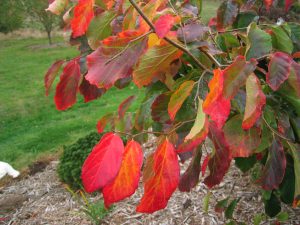
Parrotia fall color
- Parrotia persica Persian Ironwood. Graceful trees to 30′-40′, with twisting branches and outstanding fall color.
- Pinus sp. Most pines are drought tolerant; 2 needled pines are the most drought and soil tolerant. Many species and selected cultivars are available, from large trees to small dwarfs.
- Quercus sp. Moderate to large trees, many oaks, including our native oak, Quercus garryana, or Oregon White Oak, can tolerate summer drought quite well. Some are also tolerant of winter wet soils.
Shrubs
- Arctostaphylos sp. Manzanita & Kinnikinnik. Moderate sized evergreen shrubs and groundcovers. Prefer well-drained soils, drought tolerant when established.
- Aucuba japonica. Moderate to large evergreen shrubs, good for dry shade.
- Berberis sp. Deciduous and evergreen shrubs, many cultivars from small 2′ shrubs to large 12′ plants.
- Ceanothus sp. California wild lilac. Many cultivars available, most are evergreen with blue or white summer flowers. Needs well drained soil and full sun.
- Cistus. Evergreen shrubs, many cultivars available, growing from 2′-8′ depending on variety. Full sun, needs well-drained soils.
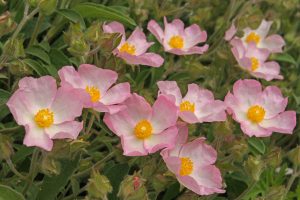
Cistus x Grayswood Pink
- Cotoneaster sp. Mostly evergreen, some deciduous shrubs, from low groundcovers to large 8′-10′ shrubs. Needs well drained soils.
- Cotinus sp. Deciduous shrubs to 10′-20′, can be kept smaller with pruning, usually grown for their attractive foliage.
- Escallonia. Escallonia are evergreen shrubs, many cultivars available, with summer flowers of pale to deep pink. Can be sheared for hedging.
- Garrya elliptica. Evergreen shrubs to 8′-10′, native to the West coast.
- Gaultheria sp. PNW Native Salal and its relatives. Evergreen small shrubs or large groundcovers, prefer moist soil in summers and partial shade but will tolerate drought in good soil.
- Grevillea victoriae Silk Oak or Royal Grevillea. Winter flowering, evergreen shrubs for well-drained soils. Hummingbird magnets.
- Hippophae rhamnoides. Vigorous deciduous shrubs with silvery leaves and edible, orange berries. Both male and female plants needed for fruit.
- Juniperus sp. Available in many shapes and sizes, from low groundcovers to medium sized trees. All need well drained soils.
- Lavendula sp. Shrubby herbs grown for their fragrant flowers. They need full sun and well drained soils.
- Mahonia sp. Oregon Grape. PNW native low Oregon Grape, PNW native tall Oregon Grape, and many hybrids are tolerant of summer drought once established. Tall Oregon Grape can also tolerate wet soil.
- Morella (Myrica) Pacific Wax Myrtle. Large growing native evergreen shrub, can be hedged.
- Pittosporum sp. Pittosporums or Tobira. Evergreen shrubs, most growing to 10′-12′ or more, easily hedged. Check hardiness for your site.
- Olea europea Evergreen shrub to small tree. Grown as an ornamental in the PNW, drought tolerant and heat loving.
- Osmanthus sp. False Holly and Osmanthus. Evergreen shrubs to 8′ or more, can be hedges. Some have holly like leaves, others are dark green. Tolerates sun or shade, sandy or clay soils.
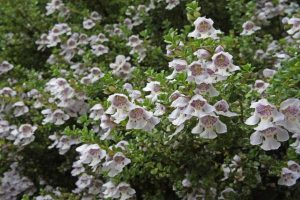
Alpine Bush Mint
- Prostanthera cuneata Alpine Bush Mint. Low, evergreen shrub, which grows to 2′-3′ high and has pink flecked white flowers. Aromatic foliage.
- Rosa sp. Species and Wild Roses. Check for disease resistance if planting hybrids; moist air can cause mildew and blackspot problems.
- Salvia rosemarinus (Rosmarinus officinalis). Rosemary. Shrubby evergreen herbs, needs well drained soils and full sun. Drought tolerant when established.
- Salvia officianalis. Sage. Culinary sage, does best in lean, dry soils. Evergreen, and requires full sun.
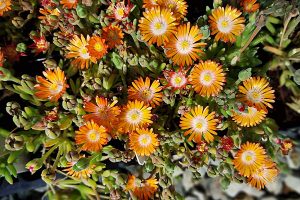
Topaz Ice Plant
Perennials & Bulbs
- Achilla sp. Low ferny foliage topped by flat flowerheads in summer. Many colors available. Can be invasive in good soils.
- Armeria sp. Grassy foliage topped in late spring by ball shaped flower heads, usually pink. Drought tolerant when established.
- Cyclamen hederifolium. Hardy Cyclamen. Fall blooming bulb, pretty patterned foliage. Good in dry shade, can compete with tree roots.
- Camas sp. Mid spring bloomers, most often blue, from bulbs. Tolerant of winter wet soils, often go dormant by early summer.
- Delosperma x. Iceplant. Succulent leaved groundcover with a long summer bloom of daisy-like flowers.
- Erigeron sp. Many species of daisy like flowers native to the West Coast, and their hybrids.
- Euphorbia sp. Deciduous and evergreen perennials of many sizes. Many will reseed. Left alone by deer.
- Frittilaria sp. Chocolate Lily. Native lily relatives with interesting checkered flowers in early spring. Summer dormant.
- Gaillardia sp. Blanket Flower. Daisy like perennials, usually in shades of yellow, orange and red. Best in full sun.
- Geranium macrorrhizum Hardy Geranium. Dense, mostly evergreen, fragrant foliage topped by pink flowers over a long period spring and early summer. Good weed smothering ability, but won’t out-compete other plants.
- Helianthemum sp. Evergreen shrublets available in many flower colors. All benefit from shearing after bloom.
- Iris tenax and hybrids Pacific Iris. Evergreen iris native to coastal California and Oregon, and Pacific Coast hybrids of Iris tenax and other West coast native iris.
- Kniphofia sp. Red Hot Poker. Tough, grassy foliage, topped by spikes of yellow to orange flowers, loved by hummingbirds.
-
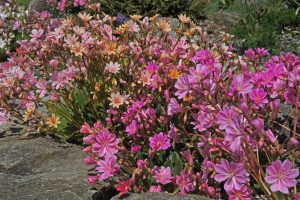
Lewisia
Lewisa sp. Bitterroot, Lewisia. Deciduous and evergreen succulents, native to the western mountains. All require lean, well drained soils.
- Nepeta sp. Gray leafed perennials for full sun. Fragrant foliage is attractive to cats; the spike of blue flowers are attractive to bees.
- Penstemon sp. Beardtongue or Penstemon. Mostly evergreen perennials or small shrublets, many native to the West, need sun and well drained soils. Loved by bumblebees and hummingbirds.
- Perovskia atriplicifolia. (Salvia yangii) Russian Sage. A shrubby perennial to 3′-4′, best in lean well drained soil and full sun.
- Phygelius sp. Cape Fuchsia. Shrubby perennials with tubular flowers, many colors available, all loved by hummingbirds. They can spread aggressively, so site them carefully.
- Salvia sp. Flowering Sage. Shrubby or herbaceous perennials with long summer blooms. Many are native to the desert Southwest and need well-drained soils.
- Sedum sp. Deciduous and evergreen succulents, many colors and sizes, more often grown for leaf texture rather than flowers.
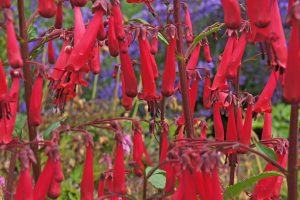
Cherry Ripe Cape Fuchsia
- Sempervivum sp. Hens and Chicks. Succulents in many sizes and colors, very easy in well drained soils, great rock garden plants.
- Epilobium (Zauschneria) sp. California fuchsia. Low, spreading mats of silvery foliage with tubular flowers of pale pink to deep orange-red mid-late summer. Needs well drained soils.
Grasses
-
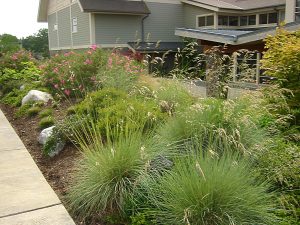
Grasses in landscape
Calamagrostis sp. Reed Feather Grass. Tall deciduous grasses, several named varieties.
- Festucas sp. Short evergreen clumping grasses, several in blues and grays.
- Helictotrichon sempervirens. Blue Oat Grass. Evergreen blue grass, moderated sized, to 2′.
- Pennisetum sp. Fountain Grass. Deciduous clumping grasses, ornamental flowers.
